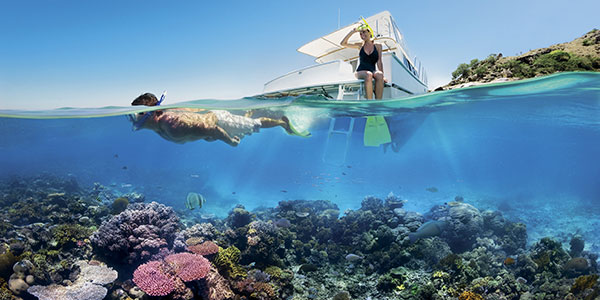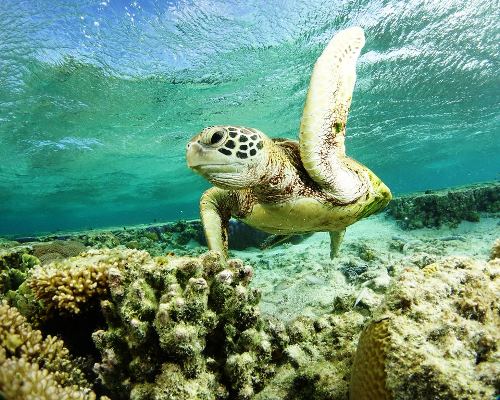
Saving The Great Barrier Reef
One of the true natural wonders of the world, the Great Barrier Reef is an underwater oasis of coral reefs, tropical species and a kaleidoscope of colour. But, as beautiful as it is, the Great Barrier Reef is a fragile ecosystem that, over time, is depleting. The largest, most beautiful and famous of its kind, our planet would be a much poorer place without it. Here, WWF Great Barrier Reef campaigner, Richard Leck, explains why it is so important we save the Great Barrier Reef and how we can protect this magical landscape.
“It’s the only living thing that you can see from space.”
The name Great Barrier Reef evokes so many images and thoughts within everyone. What makes it so special?
What makes the reef so amazing is its sheer scale. The fact that it stretches almost the entire length of the Queensland coastline, it has so many reefs, and it is so diverse, is what makes it really amazing. You don’t get the appreciation for that unless you fly up the coast or get out there on a boat and you realise what you’re looking at. There’s that famous thing that people say about the Great Barrier Reef: it’s the only living thing that you can see from space, and that’s what blows people away. And of course there’s the beauty and remarkable visual spectacle that it is.
For so many people that do experience it, it’s that sense of awe. One of the things about diving on the reef – and one of my favourite things when I was working on the reef – is just to float with your mask level with the ocean, look up at the sky and then look down underwater and see the metropolis that is a coral reef: the thousands of different fish swimming around doing their own thing, it really is just a whole other world. There’s nothing better, when you know the reef, to take people out there and experience that sense of wonder.

Is it all accessible?
To get to the outer part of the Great Barrier Reef, it does take quite a long time, particularly in the southern part of the reef. The most visitors and impactors of the reef are in the southern portion. The far northern section, which is about one third of the reef north of Cooktown, is actually rarely visited. People do expeditions and you get some live aboard dive boats and scientists, but that area is really quite remote. It doesn’t have a lot of townships, and it’s actually the most intact part of the reef.
“In the last 30 years, we’ve lost about 60% of the coral cover over the whole length of the reef.”
When you get further south, particularly in the in- shore parts of the reef, a huge change has taken place. Those areas really are not what they were even a few years ago. One of the most startling scientific studies I’ve seen in recent times is that over the whole length of the reef, in the last 30 years we’ve lost about 60% of the coral cover. Most of that loss has actually come from that southern section, and a lot of that is to do with the impact of what happens on the land – the pollution that flows from the land and the impact of cyclones. In terms of getting out there, there are still very large tourism operations, particularly out of Cairns and Airlie Beach, and those are the most popular areas to go.
For a real wilderness experience, that far northern section is spectacular. The further offshore you can get to those outer reefs, the more spectacular it becomes; you get access to better visibility. One of the issues of pollution is that it reduced the visibility in the water, because coral needs clear and clean water to thrive. The further you go from the coast, the better corals you’ll see. If I’m going to go diving, I’d head out from Cairns or Port Douglas, and I’d try and go as far north as I could, because it feels very remote and like an adventure; you get big fish, big sharks, all the stuff you wanna see.

“It is still spectacular in many places.”
Have you seen the decline for yourself?
When I started working on the reef, you think it’s just absolutely wonderful, and it is still spectacular in many places, but what opened my eyes was talking to locals and hearing their stories of what the reef had been like just a few years previous. You think they’re exaggerating, but then it was such a consistent message, and then when you hear the actual science behind that, it does open your eyes. The difference between the areas of the reef that are healthy and the areas that aren’t, it’s so stark you can’t help but be shocked by it. When you first see something, you think that’s just how it naturally is. Until you’ve been there a while, you don’t realise it’s actually a changed environment.

How has it affected the marine life that populates the reef?
One of the biggest threats to the reef is the Crown of Thorns Starfish – big, ugly starfish that eat the algae from around coral, and can consume their body weight of coral in a day. Outbreaks of those are caused by pollution from the land, in particular nutrients that come from farming, and you get these huge plagues of Crown Of Thorns that will strip a reef of its coral cover in a matter of weeks. They go from being a coral-dominated system, to something that is brown and covered in algae. That hasn’t happened to the entire Great Barrier Reef, but there are very large sections of those in-shore areas that have really changed from classic coral to quite different.

The other issue that has been very destructive is an increase in severe cyclones – seven category four+ in 10 years, an increase from three category five cyclones from 1899-1999. Due to the other threats, it takes much longer for the coral to recover from those extreme events.
Can the clock be turned back?
There are some immediate actions that we can do. People in the industry that live along the catchments can reduce pollution, improve our farming practices so we don’t have that chemical pollution, and reduce the impact of industrial development. Finally the governments have listened and will ban the practice of dumping dredge oil in the reef’s waters, which is a major milestone. Where WWF is concerned, it’s something that we need to invest a lot more money in doing. We’re worried that the government has some very ambitious targets to reduce pollution, but nowhere near the amount of funding required to implement it.
What can we do?
Get involved in campaigns with WWF and keep the pressure on Queensland governments.
By Charlotte Mellor
